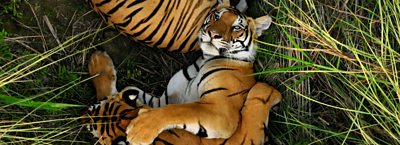Asia has more forest than any other continent – a trillion trees. Its jungles and woodlands are exceptionally diverse. They provide shelter, food and opportunity, but they are also full of dangers and hidden threats.
At the heart of the continent, the monsoon jungles of India and Nepal are ruled by the biggest of all cats – the Bengal tiger. In the last decade their numbers in Nepal have doubled. One tiger mother has her work cut out – her three almost full-grown cubs still need feeding. While they play and bathe, she heads out to hunt and after several failed attempts, she catches a chital deer fawn.
Two hundred miles to the east lives a beast that is so big that even a tiger rarely dares to attack it – the greater one-horned rhino. They weigh over two tonnes and have skin an inch thick, but even so, a third of male rhinos die in fights over territory. Wounded or tired, animals find solace in long leisurely mud baths in ponds depleted by the dry season.
A change is coming: the rains of the monsoon are hitting southern India. In the forests of Kerala, billions of cubic metres of rain trigger the appearance of one of the strangest of all Asian creatures. The purple frog spends its life underground but, just once a year, it emerges to breed. A male grips tightly to a female’s back as she seeks the perfect place to lay eggs. She must clamber across rocks battered by river torrents to find a crevice where the water level is just right. With the job done, they return underground for another twelve months. What they do there, nobody knows.
Across the Indian Ocean lie the continent’s most diverse and spectacular jungles: the tropical rainforests of southeast Asia. Orangutan live on the island of Borneo. One female seems to be unlucky in love – none of the large males she approaches are interested and they seem to be more focussed on feeding. Finally, she finds her mate - an unassuming, but attentive junior male. Nine months later her son is born and she will be devoted to him for the next eight years.
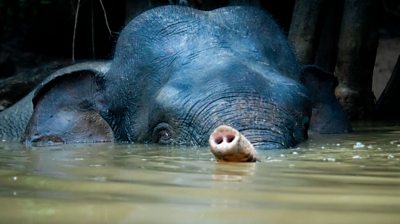
Elsewhere in Borneo, hidden amongst the trees, are the world’s smallest elephants. At a few months old, Bornean elephant calves are only about the height of a very large dog. They follow their mothers everywhere, even across fast-flowing swollen rivers. The world around them is changing rapidly, with oil palm plantations proliferating, hemmed in by electric fences. But on some farms elephants are more welcome and when it’s time to renew the crop, the herd feast on the chopped-down trees. What seems like desolation is actually an opportunity.
To the west of Borneo lies the island of Sumatra. This is the home of one of the most extraordinary plants - the titan arum. Three metres tall, it has taken ten years to mature, and yet, its flower will only open for two days. During that time, the titan produces the stench of rotting meat fooling carrion beetles who visit and carry the plant’s pollen away with them.
To the west, on the very edge of the continent, there are forests with perhaps even greater surprises in Iraq. In the region of Kurdistan grow high-altitude woodlands of oak and pistachio trees which are home to an incredibly rare cat: the Persian leopard. A female with cubs is seen for the first time in the country.
On the other side of Asia, in Taiwan, forests are home to an army of strange creatures - yellow-legged hornets. These voracious predators target bees grabbing them in mid-air before chopping them up and feeding them to their growing grubs. But the hornets aren’t immune to attack themselves. Honey buzzards have interlocking feathers that act like a sting-proof shield. They rip open hornet nests to feast on the young inside. If the queen survives, she may be able to raise a new army and rebuild her empire.
In mountains in China, seasonal forests hide perhaps the most celebrated of Asian animals – the giant panda. A four-month old cub is trying to learn an essential panda skill: tree-climbing. But it’s hard to practice when its mother keeps interfering. Eventually, the cub manages to make it a few centimetres off the ground. Exhausted by its efforts, the cub does what giant pandas do best: it naps.
- Watch all episodes of Asia on �鶹�� iPlayer and add to your Watchlist now
- Watch Asia, episode four on �鶹�� One from Sunday 24 November at 6.20pm
FS
Filming locations
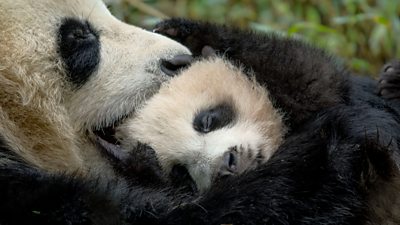
- Tiger Hunt: Community Forest, Western Nepal
- One-horned rhino fight: Chitwan National Park, Nepal
- Purple frog: Western Ghat mountains, Southern India
- Orangutan courtship: Mawas Reserve, Kalimantan, Indonesia
- Palm oil elephants: Sabah, Malaysian Borneo
- Titan arum: Batu Katak village, North Sumatra, Indonesia
- Persian leopard: Kurdistan, Iraq
- Vertical forest: Zhangjiajie National Forest Park, China
- Hornets and honey buzzards: Pingtung, Southern Taiwan
- Giant baby panda: Wolong National Nature Reserve, China
Interesting facts

- In 1966 there were only around 100 greater one-horned rhinoceros left in Nepal, but numbers have bounced back due to conservation efforts. Now there are over 700.
- The purple frog was first discovered in 2003. It’s only found in the southern part of India’s Western Ghats mountains range.
- Orangutans are found on the islands of Borneo and Sumatra and nowhere else. There are three known species and all of them are critically endangered.
- The titan arum plant can weigh up to 150 kg. Its flowering structure may only bloom once every ten years and remain open for just 48 hours before it wilts.
- Asian hornets are a social species that construct large nests from paper-like materials. A single nest can contain up to 6,000 worker hornets.
Filming Feats
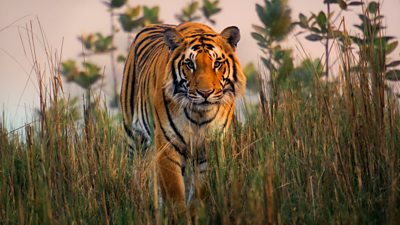
- This is the first time that drones have been used to film tigers hunting and mating for a landmark natural history series. The challenge of filming tigers from the ground is their constant disappearance into thick vegetation. Using multiple lightweight quiet drones allowed the crew to keep cameras on the tigers near-continuously throughout the day.
- It is the first time extensive Asian one-horned rhinoceros courtship behaviour has been filmed with a drone for a landmark natural history programme.
- The detailed behaviour of a carrion beetle inside a titan arum flower has never previously been filmed for a major �鶹�� landmark series.
- Very few wildlife film crews have ever ventured to Iraq, and to our knowledge, this was the first major wildlife filming expedition to take place in the autonomous region of Kurdistan. Only a handful of sightings and camera trap shots of Persian leopards in the country existed prior to the crew’s visit. Our cameras helped to capture images of multiple leopards, including the first Persian leopard female and her cubs ever recorded in Iraq. Such footage provides hope for the future of the area’s leopard populations; females are incredibly rare in the area.
Technology and filming behind the scenes
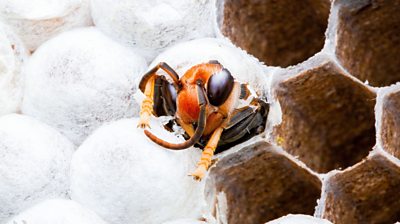
- Predicting the titan arum flower blooming event added a significant degree of complexity to the shoot. There is limited data on blooming, so our crew devised a unique technique to predict it. By smelling the plant’s potent scent, and assessing its intensity, they were able to estimate how close the flower was to opening.
- To film the tiger hunting scene the team used multiple drones, and the team had at least one drone up in the air at any one time to not lose track of the tigers. They also used thermal drones to enable them to track tigers before dawn / after sunset.
- This is the first time a specially-adapted robotic camera rig has been used to capture the development of a titan arum flower, allowing the camera to ‘fly’ around it.
- To film the Asian hornets the crew wore massive sting-proof suits made of densely woven plastic, which were incredibly hot, despite battery-powered fans integrated into the hood. Holes would frequently appear, and had to be stitched together instantly, either with tape or a safety pin, to prevent the wearer from being stung.
Interview with Patrick Evans, Producer
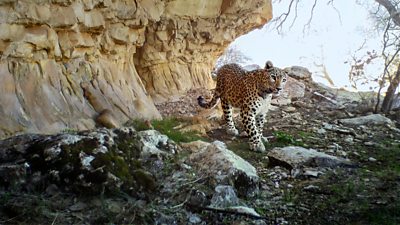
Which sequence are you most proud of in your episode?
The leopards in Iraqi Kurdistan. It was incredible when we saw the first footage. That was really very rewarding for everyone. We got the first documented live shot of a female leopard in Iraq ever. That was very exciting. Eventually she reappeared, and then finally she showed herself with cubs, which was a complete surprise. And again, that was the first shot of cubs ever achieved. So that was really quite something. Also, it was great to see the reaction on the faces of our Kurdish contributors and experts. Getting that footage was beyond our wildest dreams.
It’s the stuff that dreams are made of partly because it's hard to build a relationship with a wild animal. We project things onto animals, especially those we see so rarely and for such short periods of time on camera traps. But one thing that you can imbue those leopards with is a sense of success in overcoming the challenges they've had to face. In the mother’s case, she had navigated her way to this place, probably from Iran, across the border, through minefields and past farms and villages and places where she could easily have been shot. So for her to make it to this territory, to pair up with a male, then for that mating process to be successful and for her to rear those cubs to the age at which we saw them – you just feel great respect for that animal to have achieved these things.
What were the challenges of capturing that sequence?
Firstly, people don't really want you to go to a country like Iraq. And then, obviously there were attendant dangers such as minefields. The final thing is camera-trapping animals is extremely unreliable and difficult. But we were very lucky because we had so much support from the �鶹�� to go back there again and again in order to do it. It’s surprisingly easy to get into Iraqi Kurdistan and surprisingly safe as well. And once you're there, the Kurdish hospitality is extraordinary. The local Kurdish security services were very proud and desperately keen to make sure that we were accompanied by armed guards to places that they thought were risky. Not that it was really necessary, actually, but it was kind of them. In fact, most of the time they were keen to use it as an excuse to have a barbecue on the side of a mountain!
How did you negotiate the minefields?
The local people who we worked with and were very keen on the animals had been setting up their own camera traps there. They'd grown up in that area, and they knew where the paths between the mines were, just from information being passed on by shepherds and other locals who go up there to gather herbs and firewood. I was nervous the first few times, but I had full confidence in the guides. Land mines that have been laid decades ago can actually shift from where they were originally planted by quite some distance. But the guides were very confident about where we were going. As long as we didn't step off the path, we knew we'd be fine.
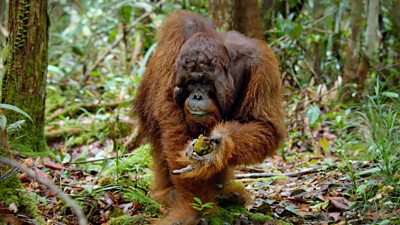
Which other sequences stand out for you?
I think we achieved something really special with the orangutan sequence that we filmed in Indonesia. We were allowed to go back three times to this one location, and we got to know this one female orangutan and her journey very well. Actually, there's a bit more to the story than is in the film. Scientists know these wild orangutans that they study by a name which they give them. This particular female was known to have just lost her first baby. So her story of looking for a mate, finding one amongst these various eligible males, and then finally having a baby was quite a big thing for her to do. It’s almost certainly the first time anybody's followed that trajectory of a known orangutan character.
Did you get help from local crews?
Yes. What was really marvellous was that it was all done by a crew based in Indonesia. They really know the forests and the animals very well. When you see the footage for the first time, it’s really exciting. You think, “We're breaking new ground here.” Even if you don't necessarily tell viewers, “This hasn't been seen before,” or, “This is incredibly rare behaviour,” what you hope is that they see and sense the novelty of it. You hope they are wowed by the fact that this is a character that we have followed through all the ups and downs. Those stories are vital because they are what engages the audience.
Which other sequences will audiences be especially gripped by?
I think the Bengal tiger sequence will be incredibly exciting for our viewers. It's the first time that this particular tiger behaviour has been filmed from the air. The drone footage offers extraordinary insights into what the tigers are thinking and what they're doing. It shows us things that we haven't seen them do before, and it gives us an ability to follow them throughout the day. Again, we had a fantastic team making that story. We filmed lots and lots of hunting behaviour. We could track them in real time with our drones, so we could see that they were hunting all the time. Once they wake up, they just go into that mode. They're just hunting constantly until they catch something. It’s amazing to watch.
What else will viewers discover about tigers from your episode?
Tigers were always thought to be very solitary. But actually, what we learned from our filming is that these tigers will be interacting and intermingling with each other more than was previously thought. The key example of that is featured very early on in our sequence. We filmed one mating pair of tigers, and then, just listening out, we could hear there was more going on quite nearby. So the operator flew the drone away from that pair and found this other pair doing exactly the same thing only a few dozen meters away. That is just unheard of because you would think the males would want to fight each other. Anyway, what we filmed for the very first time was a kind of nightclub effect!
